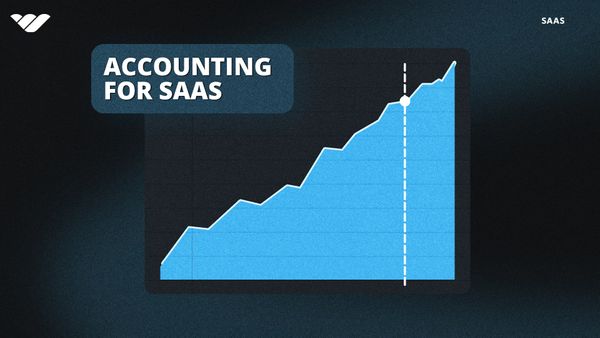As the software-as-a-service (SaaS) industry grows, accounting for SaaS companies has become increasingly important. SaaS accounting is the process of managing financial records and transactions for SaaS companies, including tracking revenue, expenses, cash flow, and taxes.
Accounting for SaaS differs from traditional businesses in many ways. For example, revenue is recognized over the life of the subscription rather than at the time of product sale. But that's just the beginning of what you need to know about accounting for software as a service.
In this guide, we'll explore what SaaS accounting is, how it differs from traditional accounting, the common challenges faced by SaaS business owners, and everything else you need to know to ensure your SaaS company's financials are in order.
What is SaaS Accounting?
Let's start with the basics, what is SaaS accounting? It’s exactly what it sounds like - the process of managing financial records and transactions for SaaS companies. It involves tracking revenue, expenses, cash flow, and taxes, among other financial activities.
As with any business, SaaS accounting is critical to the company’s success, as it enables business owners to make informed financial decisions and ensures compliance with accounting regulations. But as you’ll soon discover, business owners that sell software as a service face unique challenges in regard to accounting. First - how is this style of account different from traditional businesses?
How Accounting for SaaS Differs from Traditional Businesses
One of the key differences between accounting for SaaS companies and traditional businesses is revenue recognition. Unlike traditional businesses that typically recognize revenue when a product is sold, SaaS companies often recognize revenue over the life of the subscription. This is because SaaS customers typically pay for access to the software over a period of time, such as monthly or annually.
Another difference is the way expenses are recognized. SaaS companies may have higher upfront costs related to software development, marketing, and customer acquisition, but these expenses are often recognized over a longer period of time, rather than all at once. Additionally, SaaS companies may have lower expenses related to physical products, such as inventory and shipping.
Common Challenges SaaS Business Owners Face in Regard to Accounting
SaaS business owners often face unique challenges when it comes to accounting. One of the most significant challenges is revenue recognition, as mentioned earlier. Additionally, SaaS businesses often have complex billing systems, which can make it challenging to track revenue and expenses accurately. Saas subscription management software is often leveraged to overcome this challenge.
Another challenge is managing cash flow. SaaS companies may have inconsistent cash flow, as customers can cancel or downgrade their subscriptions at any time. This can make it difficult to plan for future expenses and investments.
Lastly, SaaS businesses may struggle with tax compliance, as tax laws can vary between states and countries. Additionally, the tax treatment of software can be complex and may require the assistance of a tax professional.
If you’re experiencing questions about how SaaS works in accounting, you’re not alone. Let’s take a look at the basics below.
How SaaS Works in Accounting
Now - let’s take a look at how SaaS works in accounting, starting with the two main types of accounting methods you can use. Then, we’ll talk a bit about revenue recognition, taxes, and other KPIs you need to be aware of.
The Different Types of SaaS Accounting Methods
There are several different accounting methods that SaaS businesses can use, including cash basis accounting and accrual basis accounting. Cash basis accounting involves recognizing revenue and expenses when cash is received or paid.
On the other hand, accrual basis accounting recognizes revenue and expenses when they are earned or incurred, regardless of when cash is received or paid. SaaS businesses often use accrual basis accounting to track revenue and expenses over the life of the subscription.
Everything You Need to Know About SaaS Revenue Recognition
Revenue recognition is one of the most critical aspects of accounting for SaaS. As mentioned earlier, SaaS businesses recognize revenue over the life of the subscription, rather than all at once. To do this, businesses must track the amount of revenue earned each period and recognize it accordingly.
SaaS revenue recognition can be complex, and there are different methods that businesses can use to recognize revenue. The most common method is the straight-line method, which involves recognizing revenue evenly over the life of the subscription. Another method is the usage-based method, which involves recognizing revenue based on how much the customer uses the software.
How do Taxes Factor into the SaaS Accounting Equation?
Taxes are a critical component of accounting for SaaS. SaaS businesses must comply with tax laws at the federal, state, and local levels, which can be complex and vary depending on the jurisdiction. Additionally, the tax treatment of software can be complex and may require the assistance of a tax professional.
One of the most significant tax considerations for SaaS businesses is sales tax. Depending on the jurisdiction, SaaS businesses may be required to collect and remit sales tax on their software subscriptions. It is important for SaaS businesses to understand the sales tax laws in their jurisdiction and ensure they are complying with them.
Other KPIs to Understand in Regards to Accounting for SaaS
In addition to typical complications in accounting for SaaS companies like revenue recognition and taxes, there are other key performance indicators (KPIs) that SaaS businesses should understand in regard to accounting. These KPIs can help businesses track their financial performance and make informed decisions about their operations. Some of the most important KPIs for SaaS businesses include:
- Monthly Recurring Revenue (MRR): MRR is the amount of recurring revenue generated by a SaaS business each month. This metric is critical for tracking the financial health of the business and forecasting future revenue.
- Customer Acquisition Cost (CAC): CAC is the amount of money a SaaS business spends on acquiring a new customer. This metric is important for understanding the cost of customer acquisition and ensuring that the business is acquiring customers at a reasonable cost.
- Customer Lifetime Value (CLV): CLV is the amount of revenue a SaaS business can expect to generate from a single customer over the life of their subscription. This metric is important for understanding the long-term value of a customer and ensuring that the business is acquiring customers with a high CLV.
The Easiest Way to Handle Your Financials: Invest in the Best SaaS Accounting Software
Investing in software is the easiest way to handle your accounting for software as a service business. SaaS accounting software can automate many accounting processes, including revenue recognition, expense tracking, and tax compliance. Additionally, it can provide valuable insights into the financial health of your business and help you make informed decisions about your operations.
In a world where time and resources are limited, particularly for bootstrapped SaaS companies, investing in accounting software can save your business time and money by automating many of the accounting processes. Additionally, it can help ensure compliance with accounting regulations and provide valuable insights into the financial health of your business.
With so many pressures of growing a SaaS business, worrying about the accuracy of your accounting is the last headache you need. Below, we’ll highlight a few things you can look for when trying to choose the right accounting software for SaaS companies.
What to Look For in Accounting Software for SaaS Companies
When choosing specific accounting software for SaaS companies, there are several factors to consider. Some of the most important factors include:
- Revenue Recognition: The software should be able to handle revenue recognition for SaaS businesses, including the ability to recognize revenue over the life of the subscription.
- Tax Compliance: The software should be able to handle tax compliance for SaaS businesses, including the ability to collect and remit sales tax.
- Integration: The software should be able to integrate with other business systems, such as CRM and ERP software.
- Reporting: The software should be able to provide comprehensive financial reporting, including the ability to track KPIs such as MRR, CAC, and CLV.
Accounting for SaaS: Key Considerations
Now that you've answered the question ‘what is SaaS accounting’, and you’re well versed in how SaaS works in accounting, you understand that it is critical to the success of any SaaS business.
This involves tracking revenue, expenses, cash flow, and taxes, among other financial activities. SaaS businesses face unique challenges when it comes to accounting, including revenue recognition and managing cash flow. Investing in the best accounting software for SaaS companies can help automate many of these processes and provide valuable insights into the financial health of the business.
When choosing accounting software for your SaaS business, it's important to consider factors such as revenue recognition, tax compliance, integration, and reporting. The right software can save your business time and money, ensure compliance with accounting regulations, and provide valuable insights into the financial health of your business.
At Whop, we offer an extensive selection of cutting-edge digital products, carefully curated and approved to ensure their top-notch quality. From trading software to reselling communities, our marketplace has everything you need to elevate your online presence.
If you're a SaaS business looking to expand your reach and streamline your operations, Whop has got you covered. Our platform provides comprehensive features like community management, payment processing, and marketing tools to help you grow your business and attract new customers.
You can explore our blog to learn more about SaaS hosting, how to calculate LTV for SaaS companies, the CAC SaaS metric, SaaS customer journey maps, and more.
👉Ready to take your SaaS business to the next level? List your software on Whop today! With our exceptional marketplace and rigorous product approval process, you can be confident that your software will find the right audience.
📚 Read next: SaaS Metrics that Matter





